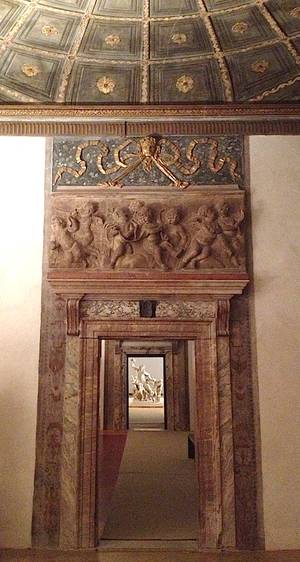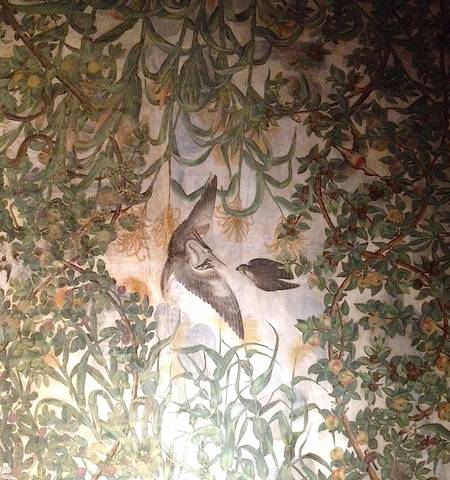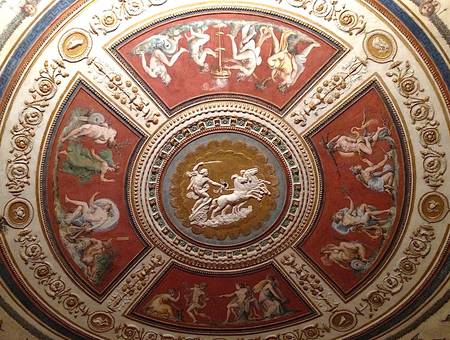Tucked away in a quiet nook in the sestiere of Castello is Palazzo Grimani, newly opened to the public, after years of restoration. I arrived late one afternoon, just as dusk was falling. As I climbed the wide stairway to the first floor, the sound of ethereal music floated down to greet me. A tall, slim woman in black was singing Josquin, accompanied on period instruments, to a small assembly in the portego. It was a magnificent way to begin a tour of this extraordinary place.
The palace was begun (so the Blue Guide tells us) around 1530 by Cardinal Domenico Grimani, son of Antonio (who was Doge from 1521–23), and work was continued to enlarge the palace by Antonio’s grandson Giovanni, Patriarch of Aquileia. It has been suggested that Jacopo Sansovino may have been involved in the work, collaborating directly with Giovanni Grimani.
Cardinal Domenico had a famous collection of Classical sculptures. At the death of his grandson Giovanni (in 1593) they were donated to the Republic, forming one of the first ever museums of Classical antiquities (and they are still on public view, constituting the main core of the Museo Archeologico in Piazza San Marco). Domenico was an important collector in other fields, too: he purchased works by Bosch, Memling and Dürer, drawings by Leonardo, and paintings by Raphael, Giorgione and Titian. At the death of the last descendant of the family in 1865, all the works of art which had remained in the palace were sold and dispersed. What you see today, as you visit the palace, are the rooms themselves, stupendously decorated in a wealth of original styles, the former backdrops for these marvellous works.

At one end of the portego, the central hall that runs the length of piano nobile, is the Cameron d’Oro where plaster casts of famous Classical sculptures (including the Laocoön) evoke the marbles once exhibited here by the Grimani. The room leading off it, the Sala a Fogliami, is perhaps the most remarkable in the whole palace, because of its ceiling, covered with a fresco showing thick foliage and fruit trees—peach, pomegranate, pear, medlar and quince—populated by birds which appear to be attacking each other. Amongst the plants the painter included maize and tobacco, recently arrived from north America. The motif of the birds, it is said, was designed to symbolise Giovanni Grimani’s stern stance against heresy, a reference to his acquittal by the Inquisition, who had accused him of unorthodox attittudes to predestination. There is a bench in the room: the best thing you can do is prostrate yourself on it, flat on your back, and just look:

The extraordinary Tribuna was designed by Giovanni Grimani to display some 130 pieces of his statuary collection. Its sober atmosphere recalls the vestibule of the Laurentian Library in Florence—and it is now empty except for the Ganymede (a Roman copy of a Hellenistic original) which has been returned from the Museo Archeologico and now again hangs from the centre of the ceiling as it did in the Grimani’s day.
The Sala di Doge Antonio, and the little vestibule and chapel adjoining, are decorated with exotic marbles. The ceiling of the chapel is decorated with the following Latin motto: “Thou has protected me, O Lord, in thy tabernacle, from the slander of tongues.” By fireplace in the main room is a bronze bust of the Doge himself, a stern-looking man. Leading off from here are the Camerina di Apollo and Camerina di Callisto, decorated in the 1530s in stuccowork and fresco.

In an adjoining room are four extraordinary panels by Bosch (c. 1503) representing Paradise and Hell, the Fall of the Damned, and the Ascension to Heaven. The image of the Fall is memorable in the extreme: like a scene from a nightmare, souls are represented as having tumbled through a great hole, and they now sit helpless in the dark, far from the light which streams through upon them, unreachable, from the manhole high above their heads.
Adapted by Annabel Barber from the forthcoming new edition of Alta Macadam’s Blue Guide Venice.






